Episode #372: How To Help Teachers Build Resilient Problem Solvers in Math – Reverse Engineering Your Goals
LISTEN NOW HERE…
WATCH NOW…
In this case study episode, we dive into a common but concerning classroom reality: students passively waiting for instructions while teachers carry the cognitive load. This learned helplessness undermines students’ mathematical thinking and independence. So, what can you do as an instructional leader to shift the culture? How can you move from answer-getting to genuine resilient problem sovlers and productive struggle? Join us as we unpack both short- and long-term leadership moves that can create the conditions for high cognitive demand and student agency in math classrooms. Whether you’re a coach, principal, or system leader, this episode offers a clear roadmap to start driving change—one intentional action at a time.
In this episode, you’ll discover:
- Why learned helplessness shows up in classrooms—and how to recognize it.
- The difference between surface-level engagement and deep mathematical thinking.
- Concrete leadership moves to foster productive struggle in the short term.
- Long-term strategies to build a culture shift from answer-getting to problem-solving.
- How to use classroom observations as a tool for change, not just evaluation.
Attention District Math Leaders:
Not sure what matters most when designing math improvement plans? Take this assessment and get a free customized report: https://makemathmoments.com/grow/
Ready to design your math improvement plan with guidance, support and using structure? Learn how to follow our 4 stage process. https://growyourmathprogram.com
Looking to supplement your curriculum with problem based lessons and units? Make Math Moments Problem Based Lessons & Units
Be Our Next Podcast Guest!
Join as an Interview Guest or on a Mentoring Moment Call
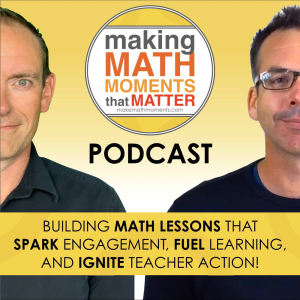
Apply to be a Featured Interview Guest
Book a Mentoring Moment Coaching Call
Are You an Official Math Moment Maker?
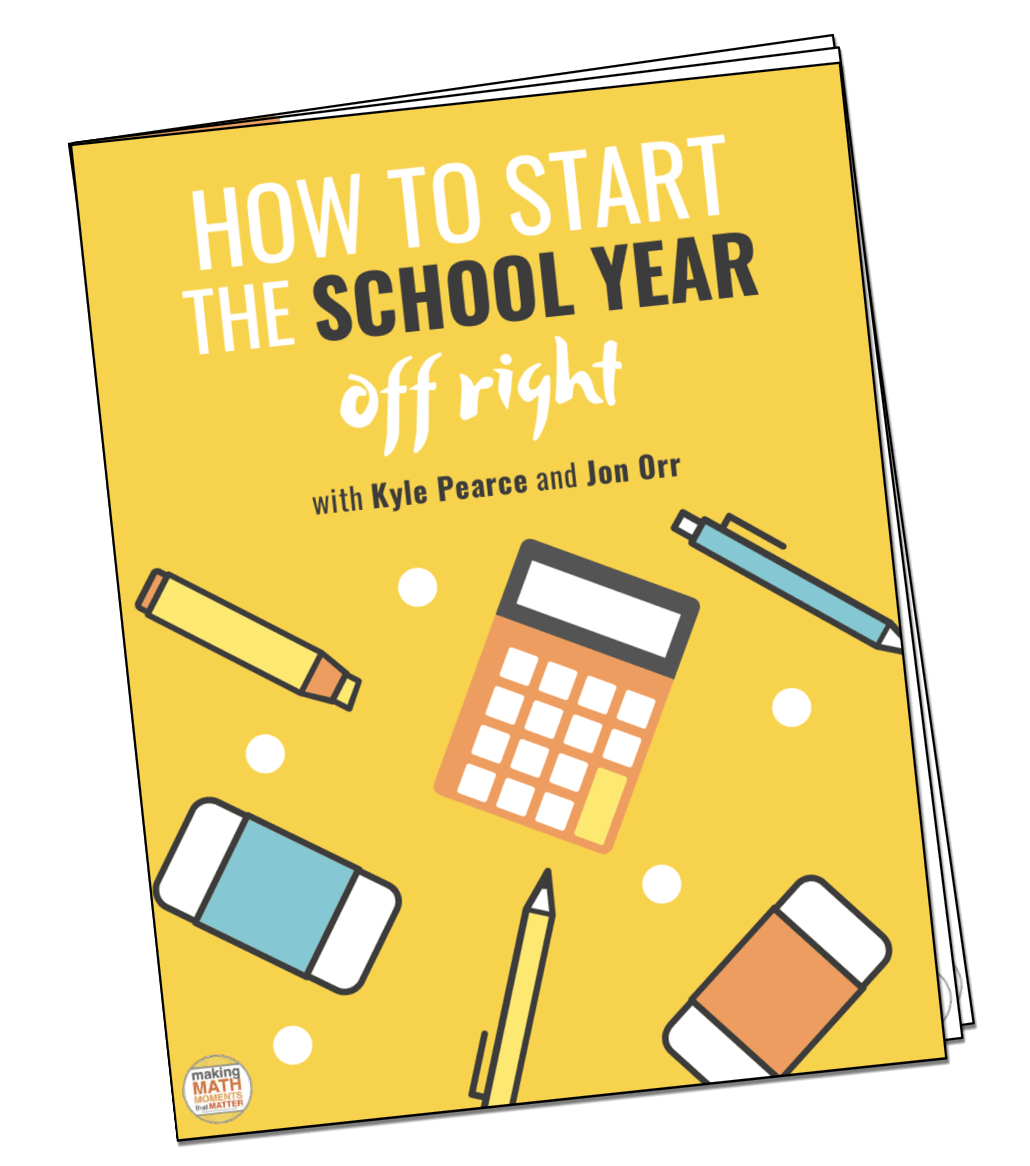
FULL TRANSCRIPT
Yvette Lehman: In this episode, we are going to just have an open conversation about a district that we partner with. And almost straight, this almost like a case study. It’s like we’re reaching out to the Make Math Moments community to help us work through a problem of practice or maybe generate some ideas of how to respond to a, let’s say a pebble that many districts are probably facing, which is this idea of productive struggle or perseverance.
I think we hear this all the time as an area that many districts want to strengthen. Many teachers will even say to you, know, my students don’t have the grit or they don’t have the perseverance or when they come across a problem that’s really challenging, they shut down. They don’t have the skills to grapple with novel problems or challenging problems. And I’m sure there are many districts leaders listening who are thinking for sure. Of course, we want our students to
come across a challenging problem and be in the position to think through it and problem solve and collaborate and ultimately find a solution, may not even be a perfect solution, but they don’t shut down and they don’t wait for someone to come and save them or funnel them or spoon feed them a strategy.
Jon Orr: Yeah, you’re right. This is a common zone that many of our district partners focus in on as an area that we want to see improved and strengthened and focused on for five, 10 years, or forever in mathematics. Because I think we view this as the heart or the core of what we’re doing in mathematics is to build resilient problem solvers. So it makes sense that we have a lot of districts who choose that focus zone. Now, when we choose the focus zone or the objective of the work that we want to strengthen throughout the year,
you know, some of the next steps. And this is where this case study is really coming from. This district, you know, has, I think, a very clear understanding of where they want to see those changes and what those some of those steps along the way are. So which is why we kind of wanted to bring this to the community to say like, this is typical. And this is what it’s going to look like. But then also, this is where some of the the stumbling blocks or the barriers come up of like, where do we go from here? And I think this is
what we wanted to talk about with this district, because they have the clarity of where they want to go. But it’s about the next steps of like, well, what does it look like to actually create improvement in that zone? And that’s where sometimes us leaders, when we’re thinking about those zones, we stay up in, in like the lofty land of like, okay, I feel like I know what this looks like, or I feel like I know what it will look like when we get there. But we need to kind of go like, what is the reverse engineering really look like?
to go from where we are now to where we want to go in the future. Yvette, unpack a little bit for us. Like, they’ve got the zone picked out. What happened next?
Yvette Lehman: Yeah, so I think that, like you mentioned, there’s a lot of clarity in this district. And they’ve gathered a lot of stakeholder voice to really own this work. So across different levels, teachers, coaches, administrators, they’re committed to creating this learning experience for students where students are doing the thinking in the classroom and students are doing the problem solving.
They’ve also really identified observable behavior. So they know what they’re aspiring to. So they know that when they have achieved this objective, these are the indicators that will tell them that they’ve achieved this objective. So, you know, students will be willing to make mistakes. Students will be, you know, sticking with a problem for a long period of time and not abandoning it, you know, things like that, things that we could actually see in the classroom through observable behavior. But then the question I’m left with is,
That’s a very clear long-term vision, and that’s really important. We have to know what we’re aspiring to. But what now? What is the immediate change that has to happen in the short term? So in three months, six months, nine months, to help us get closer to that vision we’re all aspiring to.
Jon Orr: And I don’t think you said it yet, correct me if I’m wrong, this district specifically, because they have the long-term view, part of that process is also going like, you said they had the of the descriptors of what it will look like, but that’s actually like a measurement tool that they now have built or will have clarity on building to put into place for that long-term trend measurement. Are we closer in achieving?
that zone or getting closer to achieving that objective across the district in terms of say, productive struggle and building resiliency. So a walkthrough tool is common and in the look for document is tends to be, you know, what most districts will pick, but there are long term say measures of where we want to go, not short term, but you’re saying now where the work actually comes is like, what does it look like in the short term?
to actually start to move that needle because I think like this is what I was saying before. It’s like we can, we set that and then we’re like, all right, let’s do this, this, this, and this and that should actually fix it. But what we know is that, is that those are great starting points, but there takes a little bit more of the reverse engineering, a little bit more of the details to actually understand what’s actually going to shift instruction at the district level. So what did they originally plan? And then where do we, where do we kind of help them with?
Yvette Lehman: Well, I think it’s important to paint the picture that many of us probably are familiar with, is why is this not currently happening? And I always think of it like parenting, you know, like I’m guilty of this, which is the path of least resistance, right? So sometimes it’s a lot faster for me to just do something for him or to tell him the answer.
because it gets me a faster result, it’s less frustrating for him, but we all know that that’s not going to serve him down the road, right? Like I’m enabling his dependence on me and I’m depriving him of the opportunity to think critically or problem solve on his own. And I think we’re guilty of that same thing in the classroom. So I think it’s important to identify why teachers are in this position where they feel like they need to just
tell kids how to do it or show kids how to do it. One, I think it’s because of the pressure, the frustration level, the stress level, the time. You we’re always feeling like time is never on our side. And so it’s a lot faster, easier in the short term if I just show them how to do it. So I think that we need to identify that. The other thing is that may have been how we were taught in our only experience with teaching math.
So if all we’ve ever experienced is a direct instruction approach, where we are all being funneled to a standard algorithm, I may not know any other way.
So I think that these are things we need to recognize. Like I don’t think that teachers do these things because they don’t want what’s best for their students. Just like I don’t do these things at home, you know, intentionally because I don’t want what’s best for my child. It might just be the path of least resistance or the only way that I know. So if that’s true, what do we need to happen? What change needs to happen right away?
to kind of get this momentum going, like get the ball rolling so that we can get closer to our vision of I walk into a room and what do I see? I see students digging in. I hear them debating and talking through and trying strategies and then erasing them and trying another one and maybe not even getting to an answer, but there’s a lot of really deep thinking and a lot of connections being made in that classroom. Okay.
Jon Orr: Right. So what was the recommendation for you?
Yvette Lehman: So one thing that we talked about is if I’m a teacher and all I know is how to direct instruct to the standard algorithm, then I’m going to need some capacity building myself around problem solving and approaching tasks through a variety of strategies. Because it’s really challenging to facilitate this style of lesson if I’m only comfortable with one strategy.
Jon Orr: Correct, you can’t do it, right? Like you can’t because you don’t have say, not only the pedagogical moves to kind of in the right questioning, that relies heavily on what is, do I know the continuum of math understanding on this topic and how it relates to the next topic, the previous topic? What are the models? What are the strategies that I want to bring out that is, you know,
research-based or just proven to be like, is really important understanding to actually connect different ideas together. And I think that’s where most of us have missed any sort of professional development on is helping us understand the math component at that conceptual understanding level or the model level or the flexibility.
go between concrete representational abstract to know the differences, to know how it’s connected to all the other components. I think we take it for granted that teachers will pick up on that or they have maybe their math specialists or they have math degrees and therefore they already know it, which we know is not the case. But I think you’re right, that is one of the huge barriers preventing, say, flexibility in the classroom.
is that say background knowledge, that content knowledge, building the capacity of our educators in that way. Because we focus on the pedagogy, but we can’t do that pedagogy without that other piece. And they go hand in hand. And we actually get asked questions a lot. It’s like, do I focus on the math first with teachers and then the pedagogy? Or do I focus on pedagogy and then maybe we can build in math later?
Which is, know, a very common, like, I’ve only got so much time on my hands, like, where do I, where do I focus my energy and do that reverse engineering? Like, do I have professional development sessions all year long and in year one just on building content knowledge for teachers? Because I know that’s the barrier to unlock the flexibility we want in the classroom. Or is there a way that I can do both at the same time, which I think we all want to do.
Yvette Lehman: So that was one thing that we talked about with this district was how to leverage their PLC time to prioritize the math and to engage in the five practices and with an emphasis on the anticipation stage where it’s like we’re going to identify a task within the upcoming unit that would be a good task to promote reasoning and problem solving. We’re going to anticipate student responses and also
that’s the opportunity for the knowledgeable other to bring in new strategies that might be unfamiliar to the rest of the group or that, you know, they need to strengthen, let’s say. I think that goes hand in hand, as you mentioned with the pedagogy, which is the questioning. So that’s one rule that I know that you and Kyle live by, which is where it’s like, if we’re very mindful that as students are working, we’re not going to give answers and we’re just going to ask questions.
And it’s almost like setting a time limit. Like it’s like for the first 10 minutes of this task, I’m not going to do any advice giving. I’m only going to ask questions. But asking good questions is not an easy process for teachers who haven’t engaged in it before. So engaging in that collectively through a collaboration block, I think is a good move. And so what we talked about is imagine you identify just start.
because you’re on a journey and you can’t expect transformative change within a year. Like we’re playing the long game here. But imagine within one unit you identify one task, you leverage your PLC time to work through that task, everybody solves it, you anticipate student responses, you introduce some new strategies that might be unfamiliar to the group, you plan your questions, your targeted questions.
You make a commitment to each other that we’re not going to do any advice giving for the first 10 minutes. And then as the coach, you even offer to co-teach that lesson, say like, Hey, let me know which day you’re going to do that task and I’ll come in and teach it with you, or I’ll come in and I’ll cover your teaching partner and you can co-teach it with your teaching partner. So that was kind of our maybe immediate response to this work next year. And we talked also about then how are we going to measure that?
Jon Orr: Right, I was just gonna say that. It’s like, because when you, this is where we get stuck in high level, is that we, and this is, we’ve shared this before on some of the webinars that we held, and we will put, we’ll definitely put a link to it in the show notes here about the if, then, how framework to think about. Like, that helps you get granular on the realities of like, what this could look like if I say I’m gonna focus on PLCs and supporting PLCs to help with, you know, building resilience in classrooms and in-productive struggle. It’s like, okay.
I can say that, but then it’s like, what does that actually look like? And you’re saying, well, part of that is like, we need to define what the measure is for success. And I’m going to take a step back and go, OK, if I’m going to utilize PLCs, what is required for those PLCs to be successful? So I can define the success, but then piecing that at the same time of going like,
I need a skilled facilitator. Otherwise we know that that PLC time probably won’t be utilized the way we need it to be utilized. Okay, do I have that? How many people do I have that could do that work? Can I, know, how many PLCs can we make sure that we implement in this protocol this year? And we know also that doing it once isn’t going to be enough if we’re actually expecting results. So how many of those do we need to have repeated? And therefore that all of a sudden limits
the impact, the number of teachers you’re gonna impact this year, which is like what you’re saying. This is a long-term game, but going to these depths of going like, what does that look like? Okay, I need the skill facilitator, this is how many PLCs are gonna be required for that, and we’re gonna move forward this way. Now, in the PLCs, how will I know that the PLC was actually impactful? Right, like what is the measure that we wanna hold ourselves accountable to that we actually created impact
inside the PLC so that it actually transferred into the classroom. And that part itself is also not intuitive, that like, does it look like to run a successful PLC? And maybe we actually have to dig into some learning so that we, as leaders, and maybe my TOSAs or my coaches, also have to have that learning so that we can then facilitate these at the way that we want to. So, I guess.
I’m saying is that when you set your goal, like think about what we’ve kind of outlined a little bit here is that you’ve got your objective, your focus zone, which was productive struggle. But then it’s like, how are we gonna do that? PLC was one of the, you know, one of these ways we could strengthen that up, not to say that there’s others, because what you wanna do is coordinate all those others. This is just one avenue, one channel that we can then structure. But now when each inside that,
What does success look like? Do we have what’s required to create success? If not, that’s the problem that we now have to solve so that we can go down this route. And sometimes we go down that route, we get discouraged because we’re like, that’s a lot of work. And that’s a lot of commitment. That’s a lot of time commitment. That’s a lot of resource commitment. If we’re going to envy on those PLCs, do I have the right materials to run lessons like that? Do we have to acquire those?
What is the learning expectation or the critical learning standard that we wanna highlight? We gotta select those. So when we get to the granular of that, it often makes us go like, that’s all I can do. That’s gonna take everything we’ve got to go that route. And then you just have to step back and go, is it worth it to do that work? And can I commit to it? Because that’s where the real impact happens. I just heard a quote.
that I feel like it just popped into my mind. I didn’t hear it, but I heard it before, but it was like, you know, like, you know.
Very like great results don’t come from like these great moves that we make in these short bursts. It actually is like really just doing average good work for an above average amount of time. And it’s like sustainability of like, can we commit to strengthening our PLC process to commit to the things that actually are the barriers that we have if we can commit above average amount of time to helping those groups of people.
for not one year, not one time, but a long, sustainable amount of time, that’s where you see results. It’s committing to like average work for above average amount of time.
Yvette Lehman: So I think that we’ve kind of identified some steps that this district might take, but like you said, they’re not the only ones. And so we’ll kind of put it out to the community. Like has anybody engaged in this work before? Is anybody that, you know, maybe we haven’t had direct contact with supporting productive struggle and having success in their district. We’d love to hear from you and hear what you’re doing. I read an article recently from NCTM that’s called Supporting All Learners in Productive Struggle, and they identify
you know, four components that we need to strengthen in order for this work to be successful, for this work to happen. And one of the ones that I thought, you know, it seems so simple in some ways, yet I think it really matters. And it stems from something that comes up a lot in our book that we often reference, which is systems for instructional improvement, that we also have to believe our students are capable. So if we go into this work not believing,
that our students have the skills, have the experience, have the knowledge to be able to engage in cognitively demanding tasks, we’re probably not going to get very far. And so it reminds me of, you know, just our own, our mindset and how do we support. And I think that’s what the district is starting with that we’re referencing in this case study. You know, they’re starting with the why, like why this work is worth doing and building belief that their students are not only capable, but deserve.
to have opportunities to engage in deep thinking. So this is not easy. It’s like they always say, I think like we can’t say it enough. The work that we’re doing in mathematics, leadership and improving instruction, it’s like ambitious but necessary. So we want all students to have this opportunity. We want our own children to have this opportunity. So how do we create the conditions and what do we decide to do as a, like it’s like how do we, it’s like where the rubber meets the road.
Right? Like what are we actually going to do? What is the critical change that has to happen tomorrow, next month, three months from now to start hitting those milestones? So that five years from now, when we come around with our observation tool, this is the experience that students are receiving in our district. Students are being centered in their classroom. We do believe that they’re capable. We are encouraging them to be thinkers and it’s not the teacher.
carrying the burden of all of the cognitive load and essentially funneling it to passive participants.
Jon Orr: Mm hmm. Those are, know, I’m excited for this district to take these steps. They’re at the beginning of the process, right? Like they’ve done some great work already, but now they’re coordinating. They’re getting more clarity on what’s required to achieve the outcomes that they’re hoping that they achieve. They’re getting, you know, realistic with the expectations that they could achieve based off some of the learning that they’ve done along the way with understanding,
the theory behind goal setting, the theory behind instructional improvement, the theory behind professional development sport and coordinating that support across different channels. And I’m excited for them to take that journey and to see where they come because they’ve got some clear next steps. They’ve got that clarity. think that’s going to help them move a little faster than say they would have without say that clarity.
So we’ll be keeping tabs on them as we support them in that process, but we’ll also maybe be sharing some of those updates with you in the community here in the future. If you also would love to kind of understand that roadmap, that pathway to structural improvement for your district or your school system, reach out to us. We can talk about some next steps. We can talk about what that roadmap may look like. You can head on over to makemathmoments.com forward slash district.
And if you want to say, grab our assessment. We have an assessment specifically for the six key areas for improvement at the district level and the classroom level. Just kind of see where some of the gaps might be. Head on over to makemathmoments.com forward slash report. You fill that report out, we’ll give you a customized report about some of those six key areas and where those gaps could be. But we’ll talk soon and good luck on this journey.
Thanks For Listening
- Book a Math Mentoring Moment
- Apply to be a Featured Interview Guest
- Leave a note in the comment section below.
- Share this show on Twitter, or Facebook.
To help out the show:
- Leave an honest review on iTunes. Your ratings and reviews really help and we read each one.
- Subscribe on iTunes, Google Play, and Spotify.
DOWNLOAD THE 3 ACT MATH TASK TIP SHEET SO THEY RUN WITHOUT A HITCH!
Download the 2-page printable 3 Act Math Tip Sheet to ensure that you have the best start to your journey using 3 Act math Tasks to spark curiosity and fuel sense making in your math classroom!
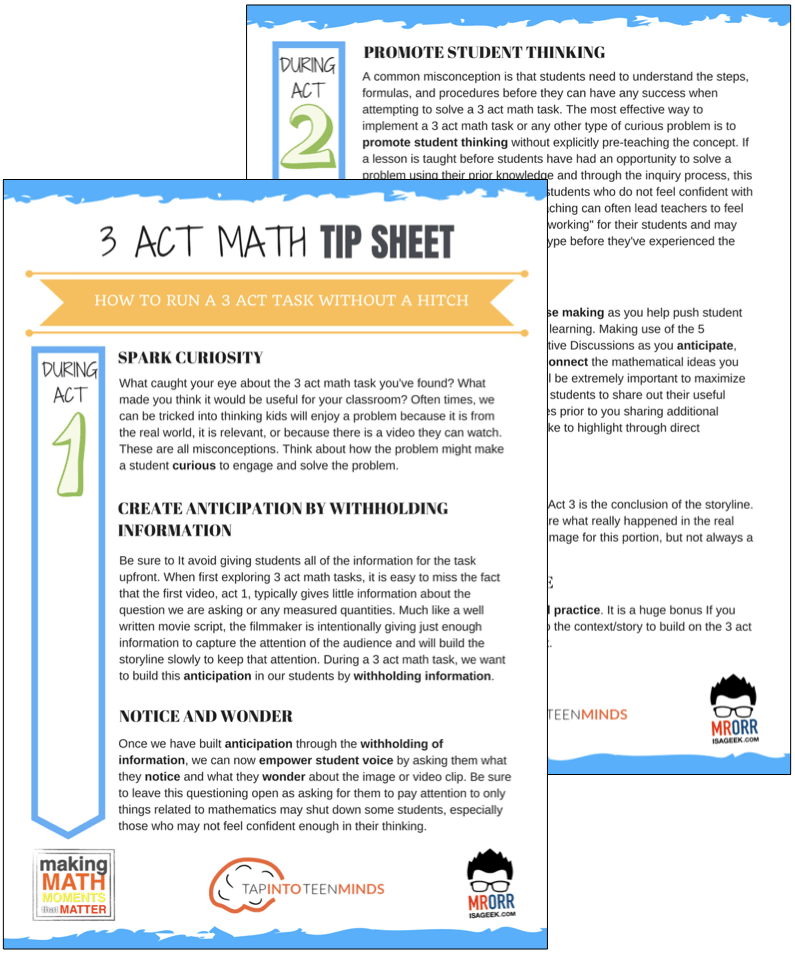
LESSONS TO MAKE MATH MOMENTS
Each lesson consists of:
Each Make Math Moments Problem Based Lesson consists of a Teacher Guide to lead you step-by-step through the planning process to ensure your lesson runs without a hitch!
Each Teacher Guide consists of:
- Intentionality of the lesson;
- A step-by-step walk through of each phase of the lesson;
- Visuals, animations, and videos unpacking big ideas, strategies, and models we intend to emerge during the lesson;
- Sample student approaches to assist in anticipating what your students might do;
- Resources and downloads including Keynote, Powerpoint, Media Files, and Teacher Guide printable PDF; and,
- Much more!
Each Make Math Moments Problem Based Lesson begins with a story, visual, video, or other method to Spark Curiosity through context.
Students will often Notice and Wonder before making an estimate to draw them in and invest in the problem.
After student voice has been heard and acknowledged, we will set students off on a Productive Struggle via a prompt related to the Spark context.
These prompts are given each lesson with the following conditions:
- No calculators are to be used; and,
- Students are to focus on how they can convince their math community that their solution is valid.
Students are left to engage in a productive struggle as the facilitator circulates to observe and engage in conversation as a means of assessing formatively.
The facilitator is instructed through the Teacher Guide on what specific strategies and models could be used to make connections and consolidate the learning from the lesson.
Often times, animations and walk through videos are provided in the Teacher Guide to assist with planning and delivering the consolidation.
A review image, video, or animation is provided as a conclusion to the task from the lesson.
While this might feel like a natural ending to the context students have been exploring, it is just the beginning as we look to leverage this context via extensions and additional lessons to dig deeper.
At the end of each lesson, consolidation prompts and/or extensions are crafted for students to purposefully practice and demonstrate their current understanding.
Facilitators are encouraged to collect these consolidation prompts as a means to engage in the assessment process and inform next moves for instruction.
In multi-day units of study, Math Talks are crafted to help build on the thinking from the previous day and build towards the next step in the developmental progression of the concept(s) we are exploring.
Each Math Talk is constructed as a string of related problems that build with intentionality to emerge specific big ideas, strategies, and mathematical models.
Make Math Moments Problem Based Lessons and Day 1 Teacher Guides are openly available for you to leverage and use with your students without becoming a Make Math Moments Academy Member.
Use our OPEN ACCESS multi-day problem based units!
Make Math Moments Problem Based Lessons and Day 1 Teacher Guides are openly available for you to leverage and use with your students without becoming a Make Math Moments Academy Member.
Partitive Division Resulting in a Fraction
Equivalence and Algebraic Substitution
Represent Categorical Data & Explore Mean
Downloadable resources including blackline masters, handouts, printable Tips Sheets, slide shows, and media files do require a Make Math Moments Academy Membership.
ONLINE WORKSHOP REGISTRATION
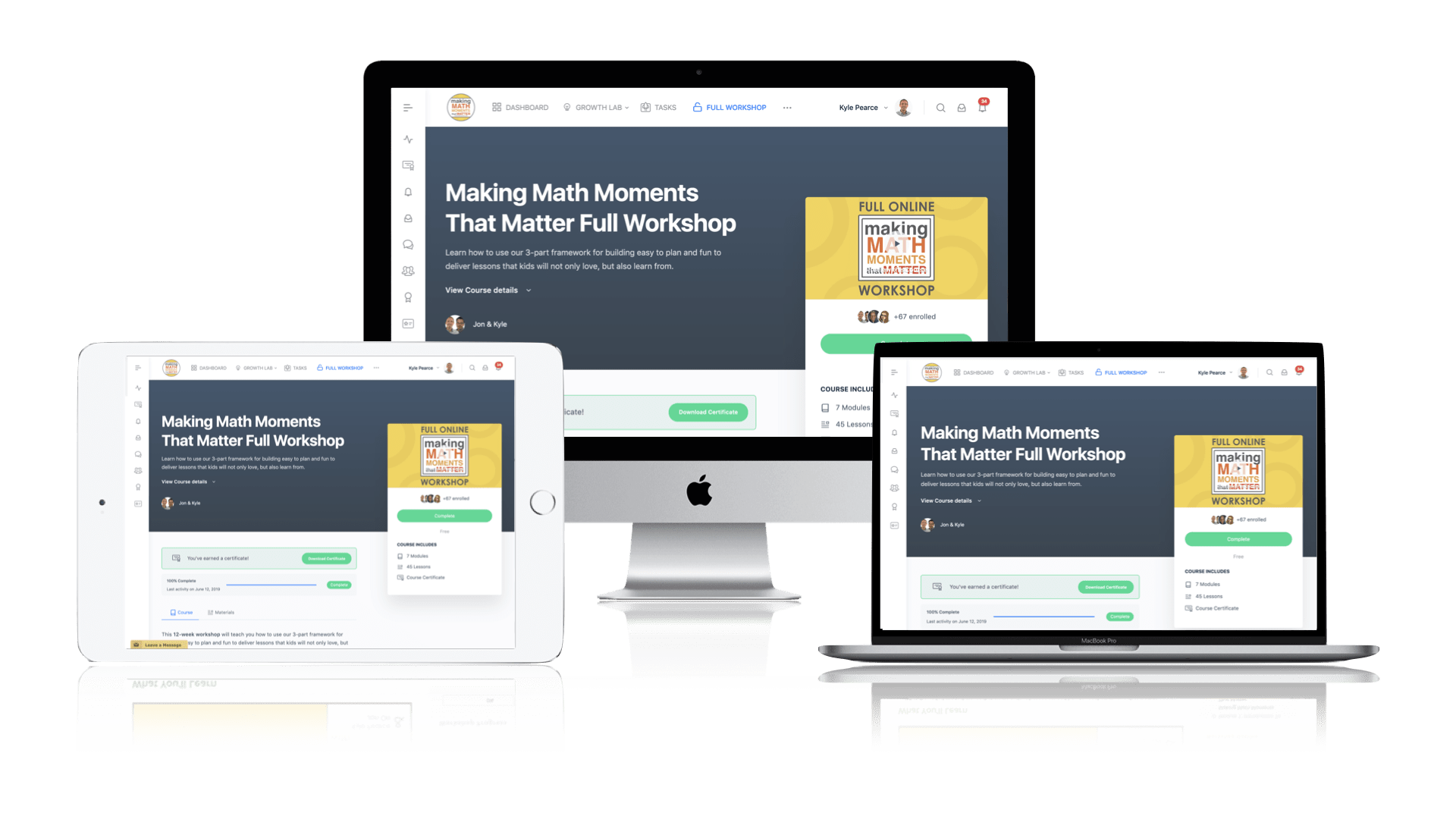
Pedagogically aligned for teachers of K through Grade 12 with content specific examples from Grades 3 through Grade 10.
In our self-paced, 12-week Online Workshop, you'll learn how to craft new and transform your current lessons to Spark Curiosity, Fuel Sense Making, and Ignite Your Teacher Moves to promote resilient problem solvers.
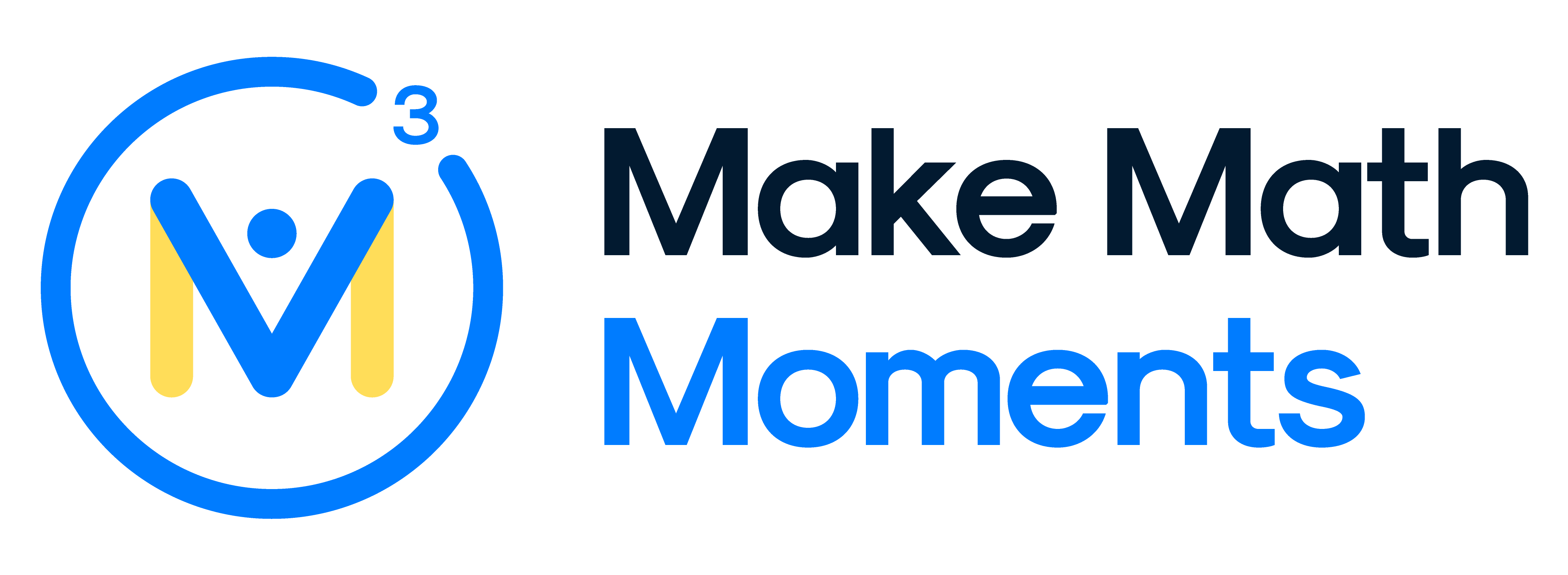



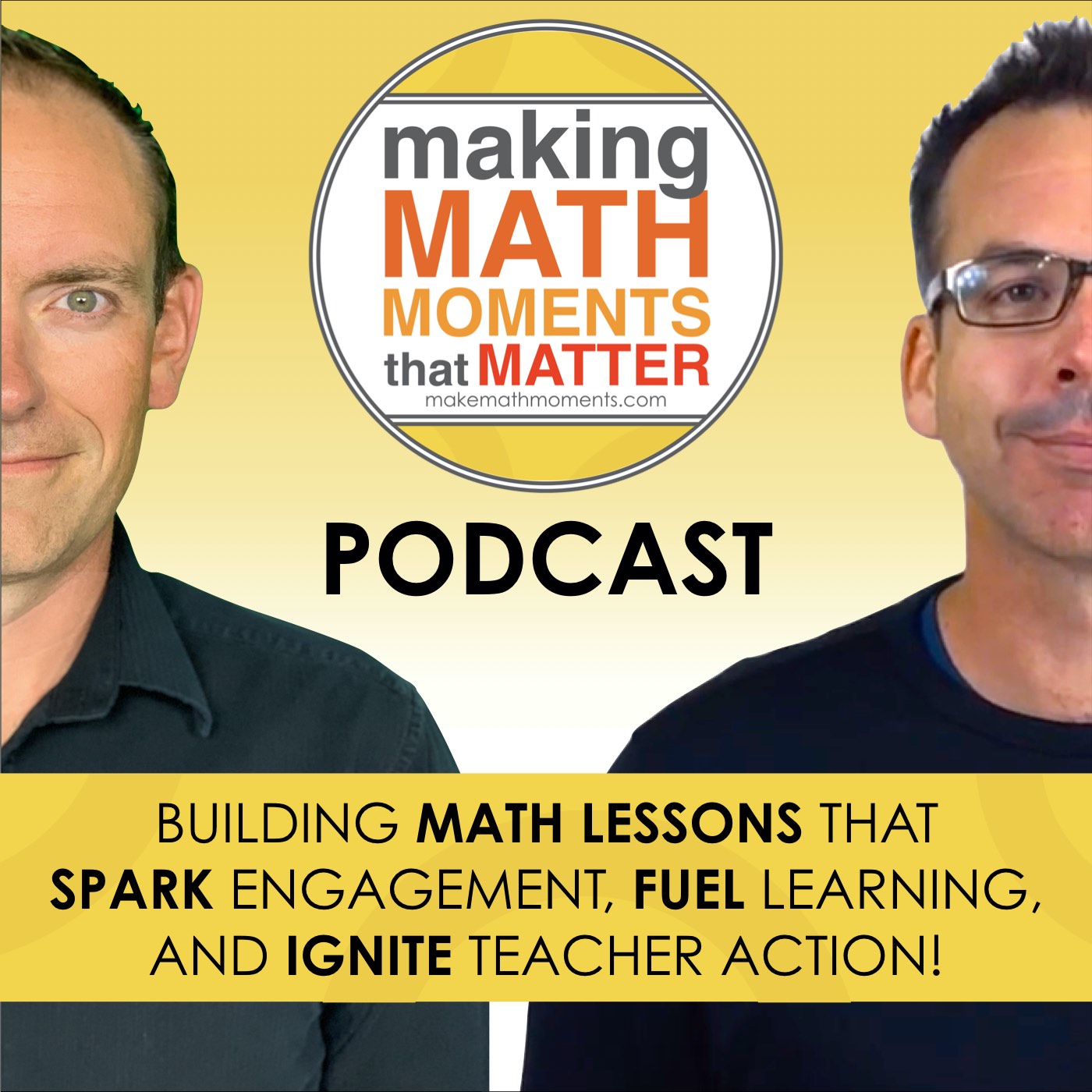
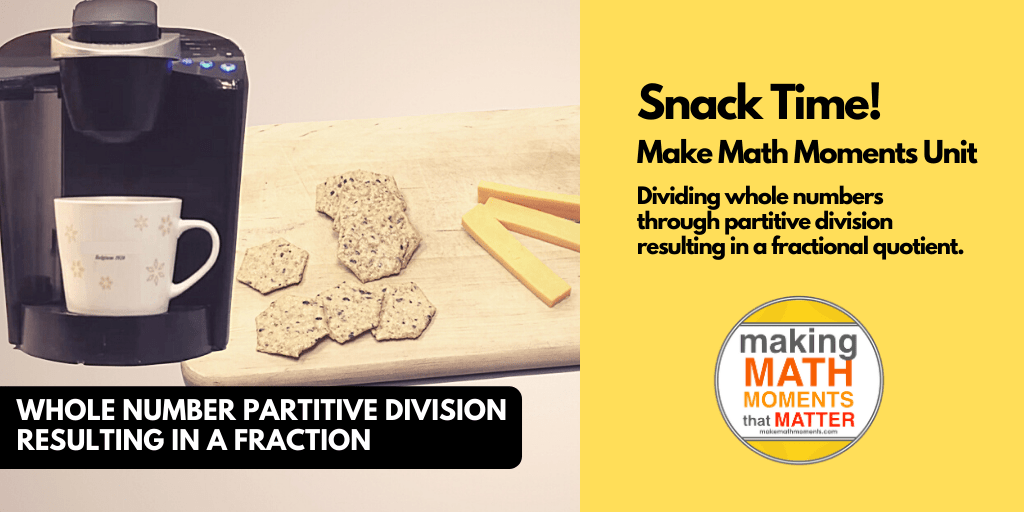

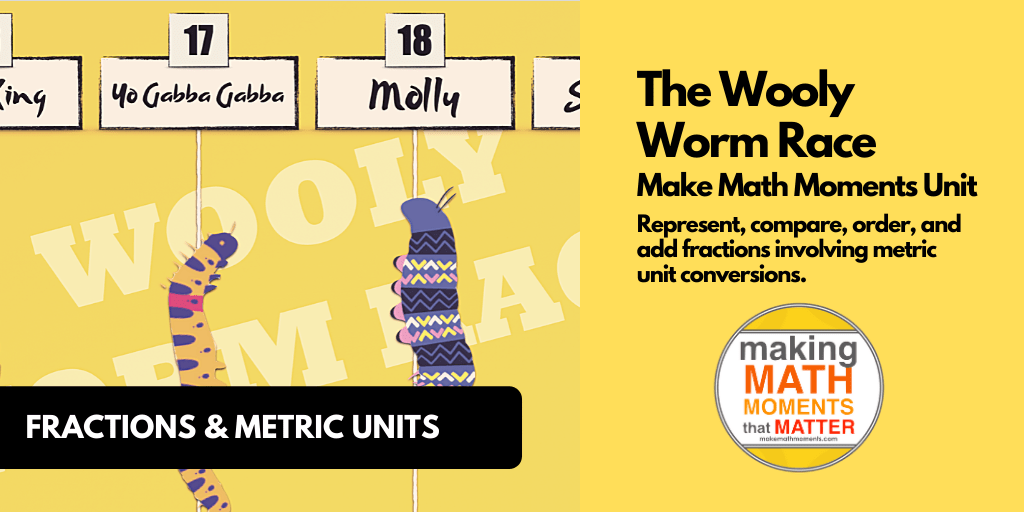
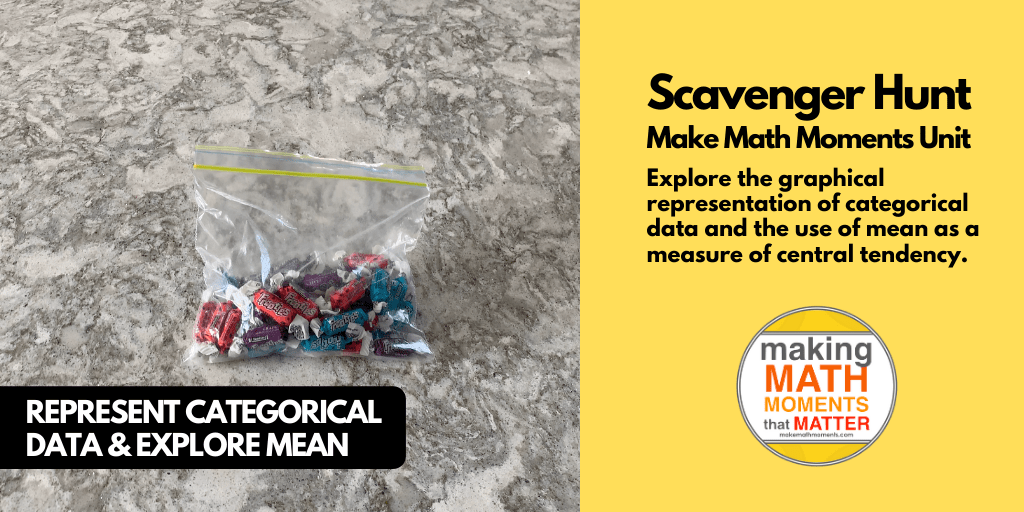
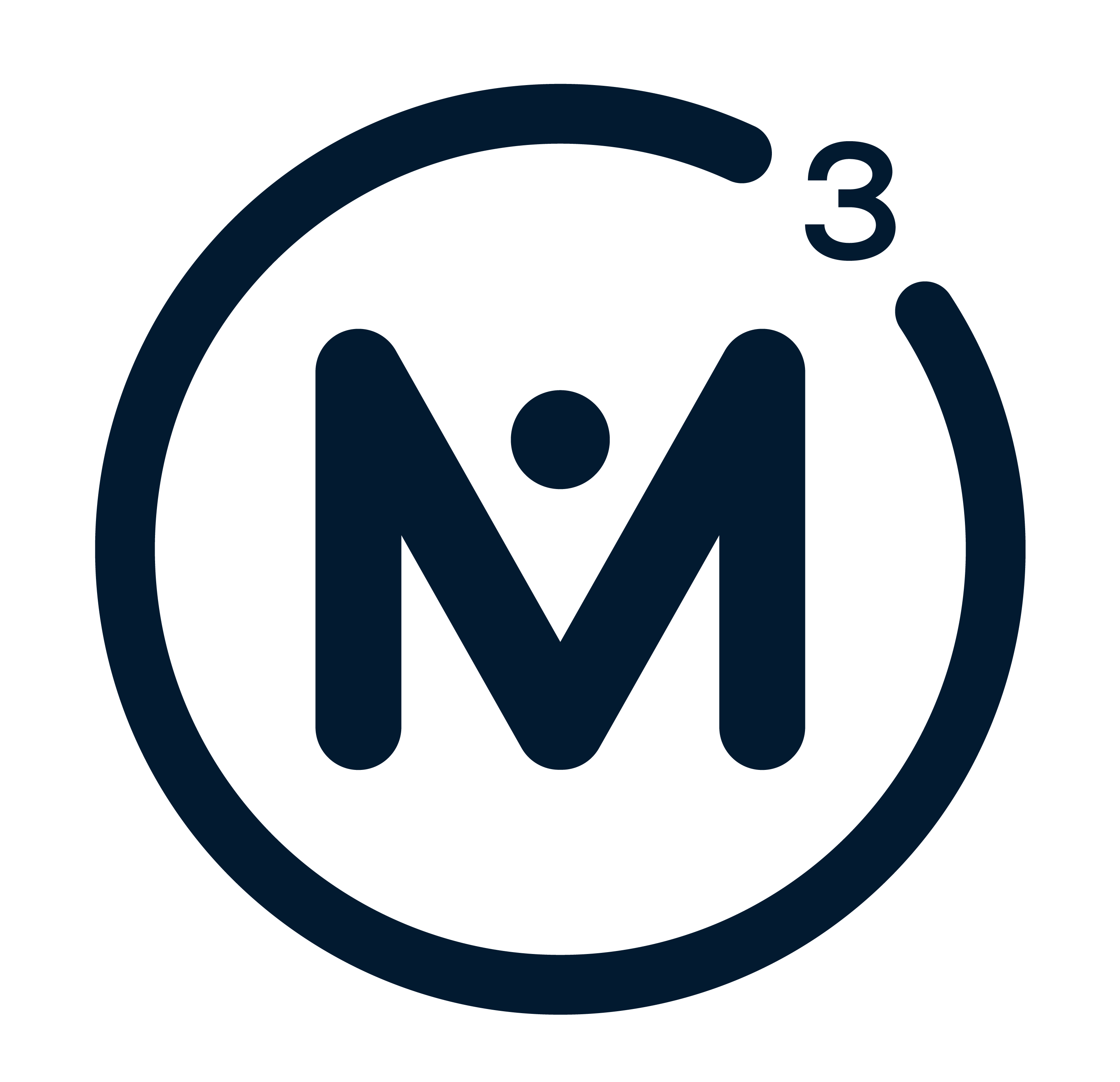
0 Comments